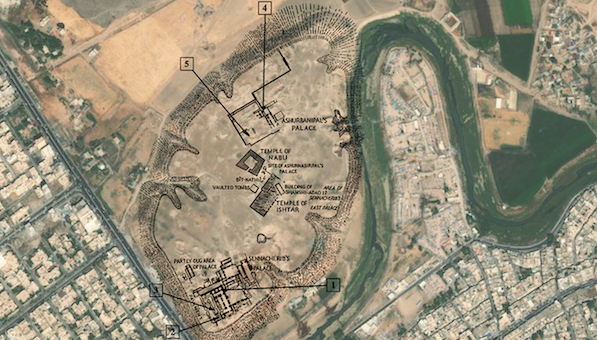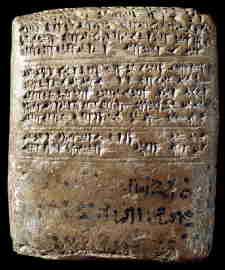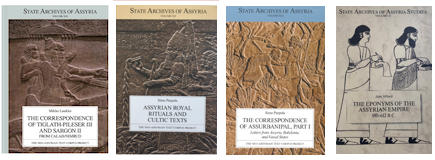You are seeing an unstyled version of this site. If this is because you are using an older web browser, we recommend that you upgrade to a modern, standards-compliant browser such as FireFox [http://www.getfirefox.com/], which is available free of charge for Windows, Mac and Linux.
Neo-Assyrian Archival Texts from Nineveh
From the reign of Sennacherib (r. 704-681 BC) onwards, Nineveh was the capital of the Assyrian empire. It was then considered to be the world's largest city: according to the Old Testament book of Jonah, it was home to 120,000 people and took three days to cross.

An old and important settlement
Nineveh is situated on the eastern bank of the Tigris, where the river Khosr joins it, at a prime location in the long-distance trade network that crosses the Middle East. Today Mosul, Iraq's second largest city, covers parts of the area of the ancient Assyrian settlement.
Thousands of years before Sennacherib [/rinap/rinap3/] moved his royal court to Nineveh and transformed the city into Assyria's political and administrative centre, Nineveh was one of northern Mesopotamia's most important settlements. But our knowledge of these periods is limited, as archaeological investigations have focused on the impressive architecture of the 7th century BC. Yet a deep excavation proves that the city already existed by the 6th millennium BC at the latest. And it is clear that Nineveh was a centre of far-reaching importance by at least the mid-3rd millennium BC because its typical pottery, which today we call "Ninevite 5", has been found in a number of ancient cities in northern Iraq and Syria.

In this letter to Amenhotep III, king Tušhratta of Mittani informs the pharaoh that, as requested, he has sent a statue of the goddess Ištar/Šawuška of Nineveh to Egypt. The cuneiform tablet was excavated at Tell el-Amarna as part of the Egyptian state archives known today as the Amarna Letters, c. 1370-1350 BC, British Museum, ME 29793 (= EA 23). Photo © The British Museum. View large image on the British Museum's website.
Nineveh was the city of the goddess known as Inanna in Sumerian, Ištar in the Assyrian and Babylonian language, and Šawuška in Hurrian and Hittite. She was worshipped in several Near Eastern cities but Ištar-of-Nineveh was considered particularly powerful. In the 14th century BC the Egyptian pharaoh Amenhotep III asked his ally the king of Mittani, who then controlled Nineveh, to let her statue visit him to bestow blessings upon Egypt.
Sennacherib's new city of residence
From the creation of the Middle Assyrian kingdom in the mid-14th century BC onwards, Nineveh was one of the most important cities of Assyria. It was always the centre of an Assyrian province and housed one of the most important garrisons of Assyria's standing army. But it was only under Sennacherib that Nineveh was transformed into the enormous city of 750 hectares that was so praised and condemned in the Bible.
The original city encompassed only the mound of Kuyunjik and its immediate surroundings in the area north of the Khosr River. Sennacherib added the territory of the formerly separate city of Nurrugum, situated on the southern bank of the Khosr River and today known as the mound of Nebi Yunus.
Tradition has it that the mound of Nebi Yunus (meaning "Prophet Jonah" in Arabic) contains the grave of the Biblical prophet Jonah, who is thought to have died in Nineveh; it is the site of an important mosque. According to the Bible, God ordered Jonah, a man from the region of Nazareth, to go to Nineveh to prophesise the immanent doom of that godless metropolis to its inhabitants. Jonah tried to escape his destiny by boarding a ship bound for Spain, as far away from Nineveh as possible. But when a storm arose, the crew blamed the runaway Jonah and threw him overboard. He survived but was swallowed by an enormous fish or whale. Finally accepting his mission after three days' thinking in its belly, Jonah was vomited out again onto dry land. He finally made it to Nineveh, where he walked through the city proclaiming, "In forty days Nineveh shall be destroyed!" Nineveh's inhabitants believed him, so the story goes, and did penance, so that God showed mercy and spared the city – for the time being.
Gates, palaces, temples and gardens
Sennacherib had a fortification wall twelve kilometres long constructed around Nineveh. Access was provided by fifteen gigantic gateways which were fortresses in their own right, with an inner and an outer gate and rooms over two storeys to house the garrisons. When the Babylonian and Median armies attacked Nineveh in 612 much of the fighting took place in and around these gates. During David Stronach's 1989 excavation of the Halzi Gate heaps of skeletons of men and horses fallen in battle came to light.

This satellite image shows the ruins of Nineveh amidst the modern city of Mosul. The course of the city walls and the mounds of Koyunjik and Nebi Yunus (covered by a mosque) on its western side are easy to make out. The southern and northern parts of the city, including Kouyunjik, are archaeological zones but the middle is covered by the modern city. Photo © Google Earth, 2010. View large image.
Sennacherib built a palace on Kuyunjik, which he lavishly adorned, as we know from the excavations that have been conducted in Nineveh since the mid-19th century AD. Sennacherib's numerous building inscriptions also describe the construction of his New Palace in great detail. Because they were composed at various times during the construction of Nineveh they allow us to trace the different stages of the enormous building project in some detail. The king shows himself especially pleased that he used stone from a new and conveniently located quarry and that the royal parks surrounding the palace employed novel ways to irrigate exotic plants such as cotton that none of his predecessors had been able to acquire.
Sennacherib also renovated the old temples of Nineveh and added new ones, such as the Akitu House and a shrine for the moon god Sin. This temple is probably where Sennacherib was murdered by two of his sons, according to Eckart Frahm.
Sennacherib's successors continued the royal building works in Nineveh. Esarhaddon [/rinap/rinap4]'s most important project was the construction of the Review Palace on Nebi Yunus. Test excavations have shown that it lies underneath today's mosque, and for that reason it cannot be explored in detail. But we can assume that the architecture of the Review Palace resembled its heavily fortified namesake in Kalhu, which the security-conscious Esarhaddon had adapted from an earlier building.
Ashurbanipal [/rinap/rinap5] renovated several of Sennacherib's buildings on Kuyunjik, among them his palace and the temple of Ištar. But he also contributed a grand structure of his own to Nineveh's architecture, the so-called North Palace. The Garden Party relief is perhaps the most famous piece among its lavish stone decorations and shows the king and queen celebrating victory over Elam in 645 BC.
For further information, see the essays "Nineveh, Assyria's capital in the 7th century BC" [/saao/knpp/essentials/nineveh/index.html], "Sennacherib, king of Assyria (704–681)" [/saao/knpp/essentials/sennacherib/index.html], "Esarhaddon, king of Assyria (681–669)" [/saao/knpp/essentials/esarhaddon/index.html], and "Assurbanipal, king of Assyria (669–c.630)" [/saao/knpp/essentials/assurbanipal/index.html] on the Knowledge and Power in the Neo-Assyrian Empire [/saao/knpp] website.
The aim of the Nineveh sub-project of ATAE is to make the published Neo-Assyrian archival texts from Kuyunjik and Nebi Yunus available online for free in a fully searchable and richly annotated (lemmatized) format, as well as to widely disseminate, facilitate, and promote the active use of these important cuneiform sources in academia and beyond. ATAE/Nineveh is more or less a 'mirror image' of State Archives of Assyria online (SAAo) [/saao/]. The principal difference between the two projects is that the contents are arranged here by archive, rather than by publication.
ATAE/Nineveh presently includes Neo-Assyrian sources edited in the following publications:
- SAA 01 [/saao/saa01/] = S. Parpola, The Correspondence of Sargon II, Part I: Letters from Assyria and the West (State Archives of Assyria 1), Helsinki 1987
- SAA 02 [/saao/saa02/] = S. Parpola and K. Watanabe, Neo-Assyrian Treaties and Loyalty Oaths (State Archives of Assyria 2), Helsinki 1988
- SAA 03 [/saao/saa03/] = A. Livingstone, Assyrian court poetry and literary miscellanea (State Archives of Assyria 3), Helsinki 1989
- SAA 04 [/saao/saa04/] = I. Starr, Queries to the Sungod: divination and politics in Sargonid Assyria (State Archives of Assyria 4), Helsinki 1990
- SAA 05 [/saao/saa05/] = G. B. Lanfranchi and S. Parpola, The Correspondence of Sargon II, Part II: Letters from the Northern and Northeastern Provinces (State Archives of Assyria 5), Helsinki 1990
- SAA 06 [/saao/saa06/] = T. Kwasman and S. Parpola, Legal Transactions of the Royal Court of Nineveh, Part I: Tiglath-Pileser III through Esarhaddon (State Archives of Assyria 6), Helsinki, 1991

- SAA 07 [/saao/saa07/] = F. M. Fales and J. N. Postgate, Imperial Administrative Records, Part I: Palace and Temple Administration (State Archives of Assyria 7), Helsinki, 1992
- SAA 08 [/saao/saa08/] = H. Hunger, Astrological reports to Assyrian kings (State Archives of Assyria 8), Helsinki 1992
- SAA 09 [/saao/saa09/] = S. Parpola, Assyrian prophecies (State Archives of Assyria 9), Helsinki 1997
- SAA 10 [/saao/saa10/] = S. Parpola, Letters from Assyrian and Babylonian scholars (State Archives of Assyria 10), Helsinki 1993
- SAA 11 [/saao/saa11/] = F. M. Fales and J. N. Postgate, Imperial Administrative Records, Part II: Provincial and Military Administration (State Archives of Assyria 11), Helsinki, 1995
- SAA 12 [/saao/saa12/] = L. Kataja and R. Whiting, Grants, Decrees and Gifts of the Neo-Assyrian Period (State Archives of Assyria 12), Helsinki, 1995

- SAA 13 [/saao/saa13/] = S. Cole and P. Machinist, Letters from priests to kings Esarhaddon and Assurbanipal (State Archives of Assyria 13), Helsinki 1999
- SAA 14 [/saao/saa14/] = R. Mattila, Legal Transactions of the Royal Court of Nineveh, Part II: Assurbanipal Through Sin-šarru-iškun (State Archives of Assyria 14), Helsinki, 2002
- SAA 15 [/saao/saa15/] = A. Fuchs and S. Parpola, The Correspondence of Sargon II, Part III: Letters from Babylonia and the Eastern Provinces (State Archives of Assyria 15), Helsinki 2001
- SAA 16 [/saao/saa16/] = M. Luukko and G. Van Buylaere, The political correspondence of Esarhaddon (State Archives of Assyria 16), Helsinki 2002
- SAA 17 [/saao/saa17/] = M. Dietrich, The Neo-Babylonian Correspondence of Sargon and Sennacherib (State Archives of Assyria 17), Helsinki 2003
- SAA 18 [/saao/saa18/] = F. Reynolds, The Babylonian correspondence of Esarhaddon (State Archives of Assyria 18), Helsinki 2003

- SAA 19 [/saao/saa19/] = M. Luukko, The Correspondence of Tiglath-pileser III and Sargon II from Calah/Nimrud (State Archives of Assyria 19), Helsinki 2012
- SAA 20 [/saao/saa20/] = S. Parpola, Royal Rituals and Cultic Texts (State Archives of Assyria 20), Winona Lake, IN, 2017
- SAA 21 [/saao/saa21/] = S. Parpola, The Correspondence of Assurbanipal, Part I: Letters from Assyria, Babylonia, and Vassal States (State Archives of Assyria 21), Winona Lake, IN, 2018.
- SAAS 2 [/saao/saas2/] = A. R. Millard, The Eponyms of the Assyrian Empire 910-612 B.C. (State Archives of Assyria Studies 2), Helsinki 1994

Click here [/atae/nineveh/pager] to visit the ATAE/Nineveh corpus.
ATAE is a key component of the Archival Texts of the Middle East in Antiquity (ATMEA) sub-project of the LMU-Munich-based Munich Open-access Cuneiform Corpus Initiative [https://www.en.ag.geschichte.uni-muenchen.de/research/mocci/index.html] (MOCCI; directed by Karen Radner and Jamie Novotny). Funding for the ATAE corpus project has been provided by LMU Munich and the Alexander von Humboldt Foundation (through the establishment of the Alexander von Humboldt Chair for Ancient History of the Near and Middle East).
For further details, see the "About the project" [/atae/abouttheproject/index.html] page. For additional information about, SAAo, visit the SAAo "About the project" [/saao/abouttheproject/index.html] page.

Home Page banner credit
Satellite image of the ruins of the citadel of Nineveh (modern Kuyunjik) overlaid with general plans of the archives and libraries (Pedersén, Archives and Libraries in the Ancient Near East 1500-300 B.C. p. 160 Plan 75). Image prepared by Jamie Novotny.
Karen Radner & Jamie Novotny
Karen Radner & Jamie Novotny, 'Neo-Assyrian Archival Texts from Nineveh', Neo-Assyrian Archival Texts from Nineveh, The ATAE/Nineveh Project, a sub-project of MOCCI, 2023 [http://oracc.org/atae/nineveh//]